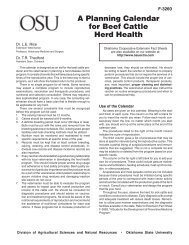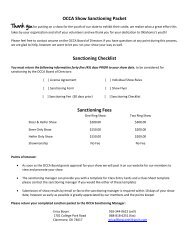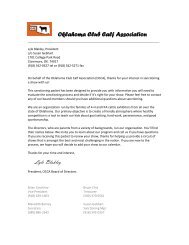Basics About Beef - the Oklahoma Club Calf Association
Basics About Beef - the Oklahoma Club Calf Association
Basics About Beef - the Oklahoma Club Calf Association
You also want an ePaper? Increase the reach of your titles
YUMPU automatically turns print PDFs into web optimized ePapers that Google loves.
8<br />
Packaged meats from most grocery stores are<br />
wrapped in film that doesn’t protect against<br />
dehydration. For freezer storage, beef should be<br />
rewrapped or <strong>the</strong> package overwrapped in a<br />
material designed for use in <strong>the</strong> freezer.<br />
3. Prepare beef for freezing before wrapping. To<br />
conserve freezer space, trim excess fat and remove<br />
bones when practical. Shape ground beef into<br />
patties. Separate individual pieces with a double<br />
thickness of freezer wrap. For those cuts of meat<br />
you plan to use for stew or similar dishes, remove<br />
<strong>the</strong> bone and cut <strong>the</strong> meat into pieces. Do not<br />
season with salt as this shortens <strong>the</strong> length of time<br />
that meat can be frozen.<br />
4. Wrap tightly, pressing out as much air as possible.<br />
5. Label properly. Indicate name of cut, approximate<br />
number of servings, and/or weight and date<br />
of freezing.<br />
6. Freeze immediately at 0°F or lower. Do not stack<br />
unfrozen packages or freeze too many packages<br />
at one time. This slows down <strong>the</strong> freezing, which<br />
may lower quality.<br />
Maintain freezer temperature at 0°F or lower.<br />
Use a <strong>the</strong>rmometer to check freezer temperature.<br />
7. Use chart below.<br />
HOW TO WRAP<br />
BEEF FOR<br />
FREEZING<br />
Place beef in center<br />
of wrapping material.<br />
When several steaks,<br />
patties or individual<br />
pieces of beef are<br />
packaged toge<strong>the</strong>r,<br />
place a double<br />
thickness of freezer<br />
wrap between <strong>the</strong>m<br />
for easy separation.<br />
Bring edges<br />
of wrap toge<strong>the</strong>r over<br />
beef. Fold over twice<br />
and press <strong>the</strong> wrap<br />
closely to <strong>the</strong> beef to<br />
force out air.<br />
Smooth ends of<br />
wrap, creasing edges<br />
to form triangles. Turn<br />
package over, double<br />
folding <strong>the</strong> ends under<br />
<strong>the</strong> package and away<br />
from <strong>the</strong> top fold to<br />
tighten it and seal<br />
out air.<br />
Seal ends with strips<br />
of freezer tape. Label<br />
package with name<br />
of cut, number of<br />
servings and <strong>the</strong> date<br />
of freezing.<br />
Freezing Cooked <strong>Beef</strong>:<br />
Cooked beef can be frozen by following steps 4-7<br />
at left. Be sure to cool <strong>the</strong> beef in <strong>the</strong> refrigerator<br />
for approximately two hours before freezing.<br />
Freezing Cured, Smoked or<br />
Ready-to-Serve <strong>Beef</strong> Products:<br />
These products do not keep <strong>the</strong>ir high quality in <strong>the</strong><br />
freezer as long as fresh beef. This is because salt in<br />
<strong>the</strong> products speeds <strong>the</strong> development of rancidity<br />
which results in objectionable flavors and odors.<br />
For best quality, limit freezer storage time of products<br />
such as corned beef and bologna.<br />
Freezing Defrosted <strong>Beef</strong>:<br />
Refreezing of completely defrosted beef is not usually<br />
recommended. This is because <strong>the</strong> quality of <strong>the</strong> beef<br />
may deteriorate between <strong>the</strong> time of thawing and<br />
refreezing. Partially defrosted beef may be refrozen.<br />
For food safety reasons, refreezing of steaks, roasts,<br />
kabobs or sliced beef is only recommended if <strong>the</strong><br />
beef has been defrosted in <strong>the</strong> refrigerator. Do not<br />
refreeze thawed ground beef products.<br />
DEFROSTING<br />
Defrost beef in <strong>the</strong> refrigerator or in a microwave<br />
oven, following <strong>the</strong> manufacturer’s directions.<br />
Defrosting meat at room temperature is not<br />
recommended — bacterial growth occurs<br />
rapidly at room temperature. The length of<br />
time for defrosting meat in <strong>the</strong> refrigerator<br />
at 35° to 40°F is:<br />
Large Roast 4-7 hours (per pound)<br />
Small Roast 3-5 hours (per pound)<br />
1-inch Steak 12-14 hours (total)<br />
Ground <strong>Beef</strong>:<br />
24 hours for 1 to 1 1 /2 inch thick patties<br />
12 hours for 1 /2 to 3 /4 inch thick patties<br />
STORAGE TIMETABLE<br />
Refrigerator Freezer<br />
Type of Meat (at 35–40°F) (at 0°F)<br />
Fresh <strong>Beef</strong> Roasts, steaks 3 to 4 days 6 to 12 months<br />
<strong>Beef</strong> for stew 2 to 3 days 6 to 12 months<br />
Ground beef 1 to 2 days 3 to 4 months<br />
Fresh Veal Roasts, chops, cutlets 1 to 2 days 6 to 9 months<br />
Ground veal 1 to 2 days 3 to 4 months<br />
Cured and/or Smoked Corned beef (ready-to-cook) 1 week 2 weeks<br />
and Ready-To-Serve Frankfurters 3 to 5 days 1 to 2 months<br />
<strong>Beef</strong> Products Luncheon meat 3 to 5 days 1 to 2 months<br />
Sausage, smoked<br />
1 week<br />
Sausage, dry and semi-dry, (unsliced) 2 to 3 weeks<br />
Leftover Cooked <strong>Beef</strong> 3 to 4 days 2 to 3 months







